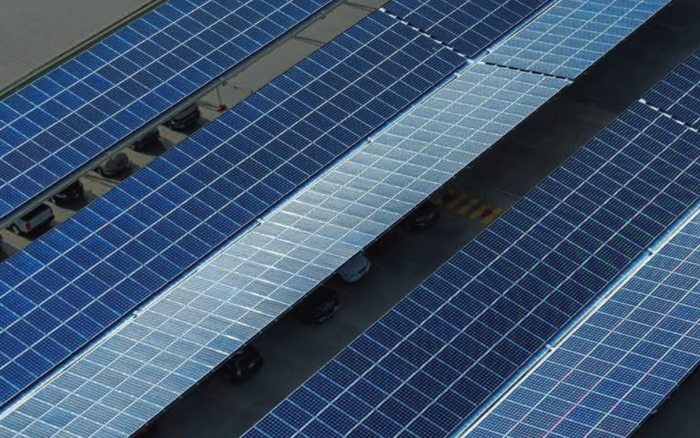
Image: Sydney Markets
Sydney Markets today officially switched on a huge addition to its previously existing solar capacity and has laid claim to having Australia’s biggest private sector rooftop solar power system at a single site.
The latest project brings the total number of solar panels installed at the Markets to 8,594, with a capacity exceeding 3 megawatts.
Last year, a 640kW solar car park structure was unveiled1 (pictured above), bringing the Markets’ renewable energy capacity at that point to about 900kW.
Collectively, the various stages will contribute approximately 11% of Sydney Markets’ annual site electricity requirements and significantly reduce energy-related carbon emissions.
“This solar system will enable us to generate sustainable energy, as well as drastically reduce our carbon footprint. In order to extract the same amount of CO2 from the atmosphere, 676 hectares of trees would need to be planted each year,” said Sydney Markets CEO, Brad Latham.
There might be even more solar energy on the horizon – enough roof space is available to more than triple the generation of what has been installed to date.
” We may continue to build upon and expand this system to meet our future energy needs,” stated Sydney Markets Chairman, John Pearson.
Among Sydney Markets’ other sustainability efforts is a commitment to reducing waste, with at least 70% being recycled on-site. Even some of the waste that makes it out of the gates of the markets has a connection to energy – produce unfit for sale is taken to Veolia’s Earthpower waste-to-energy plant, with the byproduct of its process used for fertiliser.
Sydney Markets operates 24/7 and covers 43 hectares, making it one of the largest food distribution centres in the Southern Hemisphere. 2.5 million tonnes of fresh produce with a value exceeding $3 billion is traded at the markets each year. It’s also a major employer, with 5,000 workers.
Commercial solar power, particularly small-scale (<100kW), is becoming increasingly popular among businesses in Australia. RenewEconomy’s Sophie Vorrath noted in January that the commercial sector “really put a rocket under PV growth” last year.
With the plummeting cost of solar panels, coupled with increased efficiency in installation and various financing options, it’s reached a point that if a business can afford to pay its electricity bills, it can afford to go solar – and then start slashing its energy costs.
Footnotes
- The solar car park project was briefly the largest in Australia. It was beaten a few months after its completion by an installation at Westfield Marion in Adelaide’s south-west – by 7kW ↩

 RSS - Posts
RSS - Posts



Speak Your Mind